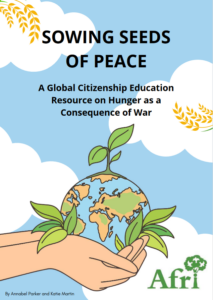
Sowing Seeds of Peace
This resource is for post primary school teachers who wish to facilitate understanding of the interconnection between war and hunger. The Resource itself is divided
This guidebook has been developed to support teachers and students in learning about greenwashing as a barrier to sustainable development.
Have you ever asked yourself, What do fashion companies and EU lobbying have to do with greenwashing, but not know where to begin your learning journey? Well, same here!
With the above in mind, we decided to create part three of the greenwashing guidebook series which explores two case studies which open up greenwashing as a ‘live issue’ based on the supply chain of the fast fashion company Shein and the activities of the European initiative to ban fossil fuels advertising.
More specifically, part three sets out to:
For more, check out:

| Subject | Learning Outcome | Learning Outcome Detail |
|---|---|---|
| LC Geography | LO 4.5 | Discuss environmental pollution at a local/national and global scale. |
| JC Business | LO 1.9 | Debate the ethical and sustainability issues that arise from their consumption of goods and services and evaluate how they can contribute to sustainable development through consumer behaviour. |
| LC Home Economics | LO 3.8 | Discuss the influences of trends and choices on textile and clothing, including ethical and ecological considerations. |
We are learning to:
By the end of this case study, students will be able to:
Fast fashion refers to
‘the trend of producing and selling clothing at a rapid pace, with styles changing quickly and low-cost materials being used. This results in frequent purchasing and disposing of clothes, contributing to environmental and ethical concerns’.
– Throwaway & Fast Fashion by Mukesh Kumar
The principles of fast fashion can be broken down into the following four categories (summarised by Mukesh Kumar):
| Speed | The production and sales cycle are accelerated, with new styles being introduced rapidly. |
|---|---|
| Low-Cost Materials | Clothing is made with inexpensive, low-quality materials to keep costs down. |
| Trend-Driven | Styles are based on current fashion trends and change frequently to encourage customers to purchase new items. |
| Disposability | The short lifespan of the clothing and its low cost encourage consumers to dispose of it quickly and purchase new items. |
Task: Read the description below to see how (in their own words) Shein’s use of a digital supply chain impacts their ability to respond to trends and consumer choices.
‘We [Shein] have built a fully digital supply chain that seamlessly and quickly delivers products to our customers worldwide. We use proprietary software to track sales and communicate with our factories in real time to order and in small batches. Our digital supply chain is the core of our business model and empowers us to offer a wide range of on-trend styles … without making customers wait weeks for their orders to be fulfilled’
| Strongly Agree | Agree | Neutral | Strongly Disagree | Disagree |
|---|---|---|---|---|
3. Justify your stance:
Shein’s unique business model relies on an ’empowered and agile’ supply chain to quickly produce and deliver new products in response to consumer demands.
Hence, Shein (similar to many other companies that respond to fashion trends by supplying a constant demand for cheap clothing items) has quickly raised concerns about the environmental harm caused by the company and how the company may contribute to labour exploitation.
To mitigate against environmental degradation Shein launched a sustainability campaign in 2022.
The announcement of the sustainability campaign took place in July 2022, where Shein pledged to donate a total sum of fifteen million dollars (over three years) to a non-governmental organisation working with a textile community at Kantamanto in Accra.
The evoluSHEIN Roadmap
In June 2023, Shein announced their evoluSHEIN Roadmap, which aims to be
‘a comprehensive strategy for addressing social and environmental challenges and making a positive impact as the company evolves into the future.’
As part of the roadmap Shein established a number of targets to achieve by 2025 and by 2030.
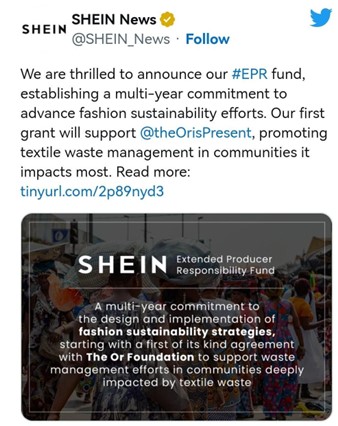
Graphic: Sustainability Campaign/Shein announcement on Twitter (7th June 2022)
As outlined in their sustainability and social impact report 2022, Shein is committed to advancing the United Nations Global Compact’s (UNGC) Ten Principles.
More specifically, Shein focuses on the following three sustainability commitment goals:
1. Work to align our programs and reporting with international frameworks.
2. Strides in enhancing sustainability throughout our products’ lifecycle, from preferred materials to responsible manufacturing processes and promotion of the circular economy.
3. Development of the evoluSHEIN roadmap, which will help drive ongoing efforts while creating a baseline for us to measure our
success.
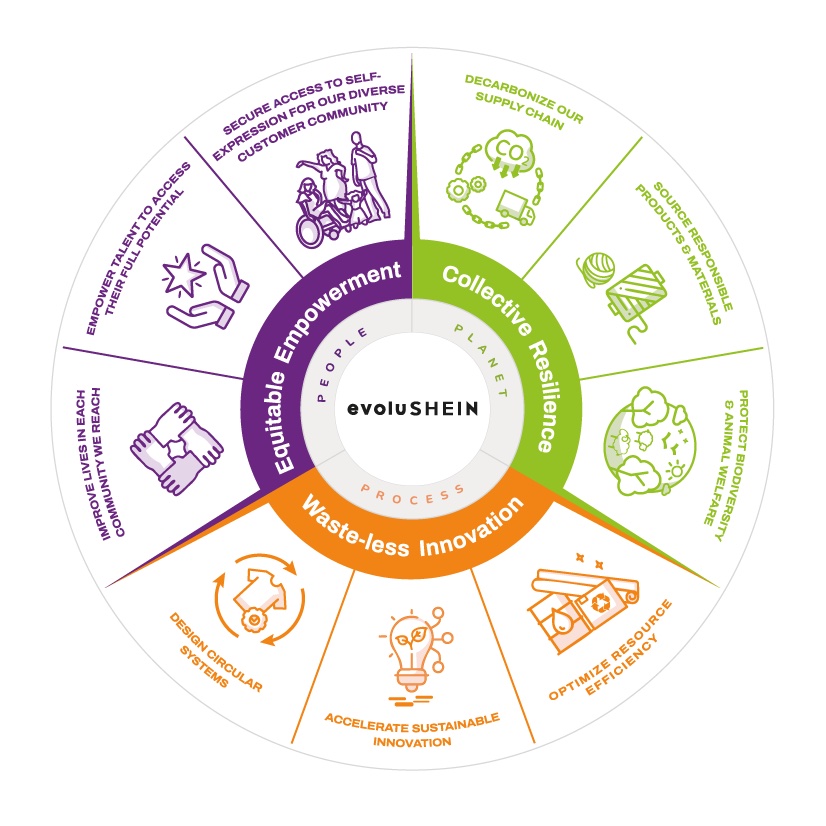
Read this article by The Guardian for further information on the fifteen million dollar pledge Shein made to the charity the Or Foundation.
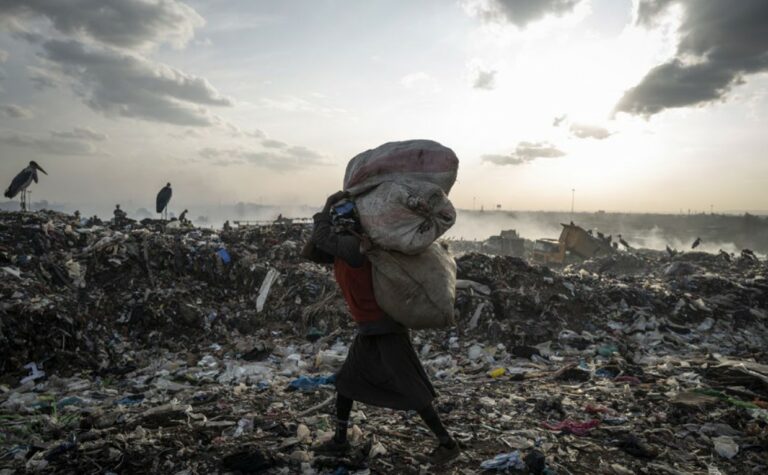
Run time: 50:55
‘Nowhere is the failure of the fast fashion linear business model more visible than in the countries where many of these cheap clothes end up once their short lives are over: on huge dump sites, burnt on open fires, along riverbeds and washed out into the sea, with severe consequences for people and the planet’
Task: Answer the following comprehension questions:
|
Bloom’s Taxonomy Point 1: Remembering Q. What is Shein, and what is its unique business model? |
|---|
|
Bloom’s Taxonomy Point 2: Understanding Q. What are some of the concerns that have been raised about Shein’s business practices? |
|---|
|
Bloom’s Taxonomy Point 3: Applying Q. How can consumers hold Shein accountable for its environmental practices? |
|---|
|
Bloom’s Taxonomy Point 4: Applying Q. What are the benefits and drawbacks of Shein’s business model? |
|---|
|
Bloom’s Taxonomy Point 5: Evaluating Q. Do you think Shein’s efforts to address its environmental impact are sufficient? Justify your stance. |
|---|
Task:
In groups of four, create a sustainable fashion plan for Shein or another appropriate fast-fashion retailer to transition from a fast-fashion retailer to sustainable fashion retailers.
Materials Needed:
1
Step 1: Have each student write ‘Creating a Sustainable Fashion Plan’ as the title for this activity on the top of their A3 page.
2
Step 2: Have students brainstorm a list of sustainable practices Shein/other appropriate fast-fashion retailers could implement to become a sustainable fashion retailer.
3
Step 3: Have each student in the group, using their assigned coloured pen (Student Green, Student Red, Student Blue, Student Black), jot down what, in their opinion, are the three ‘best’ approaches:
| Student Green | Student Red | Student Blue | Student Black |
|---|---|---|---|
|
● For example: Offering more sustainable shipping options.
● ● |
● For example: Using environmentally friendly products.
● ● |
● For example: Encouraging sustainable fashion practices among customers through education and awareness campaigns.
● ● |
● For example: Implementing a Circular Economy Approach.
● ● |
4
Step 4: Based on a group discussion, have students work together to narrow down the list of 12 approaches to two approaches, and have each team work together to justify their stance.
|
Approach #1: _____________________ Rationale for choice |
|---|
|
Approach #2: _____________________ Rationale for choice |
|---|
5
Step 5: Have each group select one approach and create a comprehensive sustainable fashion plan for their chosen company for how the company can, for example, implement steps, communicate effort and engage with members of the public etc on their second A3 piece of paper.
As outlined by educators Conor Harrison and Máirín Wilson in the Civic Social and Political Education (C.S.P.E.) resource Make A Difference,
‘being fashionable has happened at the expense of the environment. Textile production, the materials needed to produce clothes, has to keep up with fast fashion. This results in significant CO2 and greenhouse gas emissions that pollute the air and exacerbate the climate crisis. The fashion industry is responsible for 8% of global carbon emissions.’
‘The choice of clothing materials is a crucial element of fast fashion, with many fast-fashion retailers using non-biodegradable fabrics or cotton. The growth, manufacturing, transporting, and washing of cotton uses vast amounts of water (It takes approximately ‘2,700 litres of water to make one t-shirt’).’
Furthermore, these dyes are harmful to human health:
‘the dyes that go into the brightly coloured fast fashion pieces also pollute the environment, particularly rivers, while cheap textiles used in fast-fashion (called polyester) shed tiny microfibres that add to ocean pollution’.
Read the infographic-driven civil society report Trashion – The stealth export of waste plastic clothes to Kenya, highlighting how fast fashion is destroying our world, explicitly referencing fashion’s environmental impact on the Global South.
‘As clothing production has skyrocketed in the past two decades, an increasing proportion of clothing is made from cheap synthetic fibres. As a result, synthetics account for sixty-nine percent of all fibre production and have become the backbone of fast fashion.’
Atacama desert in Chile where over 100,000 tons worth of clothes are dumped.. pic.twitter.com/b54Hy8j5O6
— 𝘙𝘦𝘨𝘨𝘢𝘵𝘵𝘢 𝘥𝘦 𝘉𝘭𝘢𝘯𝘤 🆓 (@crk5) January 8, 2022
Inform the class that you are going to call out the statements on the board one by one and that they are to engage in the class activity by walking to the ‘agree’ or ‘disagree’ part of the room for each statement (depending on their stance on each statement).
Inform students of the rules of classroom discussion activity. For example, only one student may speak at any given time.
Where appropriate, ask students with the ball prompt questions. For example, as outlined in the Power and People: Teacher Workbook, to facilitate a successful moving debate, consider asking students probing questions such as:
| Post-Moving Debate Reflection Form |
|---|
| 1. Which of the statements above did you agree with the most? Why? |
| 2. Which of the statements did you disagree with the most and why? |
| 3. Did your opinion on any of the statements change during the debate? |
| 4. Do you feel that you made a good contribution to the moving debate? |
| 5. What can you do to ensure that you make a better contribution to the next moving debate? |
Note: This reflection sheet is adapted from Power and People – A Teacher’s Resource Book by Joseph McBride, 2018: 33.
A. A sustainable fashion brand
B. Local clothing swaps
C. Repairing items of clothing
D. Other appropriate option
Note: Remind students that some companies, despite being fast fashion retailers, have lines of clothing and footwear made from recycled materials
3. Ask each group to create a presentation on one sustainable fashion brand or alternative to fast fashion. The presentation should cover the following:
| 1. | What did you learn about sustainable fashion brands or alternatives to fast fashion? |
| 2. | How can you incorporate sustainable fashion into your consumer behaviour? |
| 3. | What are some challenges you might face when trying to buy sustainable fashion? |
| 4. | What are some strategies for overcoming these challenges? |

| Subject | Learning Outcome | Learning Outcome Detail |
|---|---|---|
| LC Civic, Social and Political Education (CSPE) | LO 2.10 | Evaluate how they can contribute to responding to one challenge currently facing the world. |
By the end of this case study, students will be able to:
Trócaire, in the document Climate Change Climate Justice defines climate change as a significant change in weather trends and patterns experienced by a region. While this can be caused by natural factors, the term climate change now describes changes in our climate as a result of human activity.
Watch the following video titled What is the Carbon Cycle by the National Oceanic and Atmospheric Administration.
Lesson Hook: Write the statement below on the whiteboard and ask the class why they think people have started fighting fossil fuel advertisements recently.
Statement:
“Activism works. If we could ban tobacco advertising and sponsorship, we can ban fossil fuel propaganda, which is needed more now than ever as the louder the call for climate policy, the more the fossil fuel industry advertises”
The Ban Fossil Fuels Ads is a European Citizens’ Initiative to Ban Fossil Ads, but what is a European Citizens’ initiative?
As outlined on the Ban Fossil Fuel Ad’s website, the common goal of those who signed the petition is to legally prevent the fossil fuel, vehicle, airline and maritime industries that use fossil fuels from advertising and sponsoring in the European Union.
Moreover, the coalition of organisations involved aim to prevent such companies from spreading climate disinformation, which delays climate action and acts as a barrier to sustainable development. This practice is well documented, such as this Guardian news report summaris, titled ‘A great deception:oil giants taken to task over ‘greenwash’ ads‘ by Damian Carrington in April 2021.
We are in a climate crisis that is leading to a global human rights crisis of unprecedented proportions. Many communities on the front line of the climate crisis, particularly those in Africa, Asia and Latin America, are already facing the devastating consequences of more frequent and intense droughts, floods, cyclones and rising sea levels, which have also now reached Europe. For the very first time, the latest Intergovernmental Panel on Climate Change (IPCC) report stated that corporations have attempted to derail climate mitigation by targeted lobbying, doubt-inducing media strategies and through corporate advertising and brand building to deflect corporate responsibility to individuals. This climate science report also recommends regulating corporate advertising. According to the Climate Accountability Institute, companies like Total Energies and Royal Dutch Shell, who are among the top 20 most carbon polluting fossil fuel companies in the world, continue to promote their dangerous businesses via advertisements and sponsorships.
The above quote, taken from the Ban Fossil Fuel Ads campaign’s website, concisely outlines the importance of the European Citizens’ Initiative to Ban Fossil Ads, which launched in October 2021.
A number of short videos released by the campaign group to raise awareness went viral as ‘how to’ videos from marketing and PR perspectives. Here are two:
Working in PR for Oil companies
— Michael Fry (@BigDirtyFry) September 16, 2022
If you’d like to stop fossil fuel companies misleading consumers with their advertising like this you can sign the petition at 👉https://t.co/nCWMwOhL4F #banfossilads #ad pic.twitter.com/iOHsTu38P1
Progress updates since the campaign launched in June 2021 include:
The Intergovernmental Panel on Climate Change (IPCC) is the United Nation’s body for assessing the science related to climate change. The IPCC prepares comprehensive Assessment Reports containing the most up-to-date ‘knowledge about the state of scientific, technical and socio-economic knowledge on climate change, its impacts and future risks, and options for reducing the rate at which climate change is taking place.
When was the IPCC set up?
Trócaire, in the document Climate Change, Climate Justice 2, describes that:
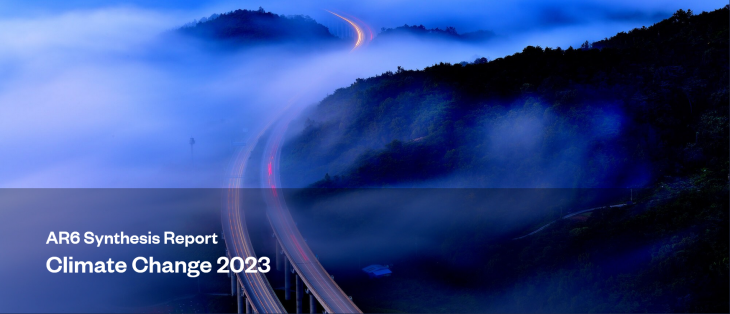
“This report is a clarion call to massively fast-track climate efforts by every country and every sector and on every timeframe. Our world needs climate action on all fronts: everything, everywhere, all at once.” – UN secretary general, António Guterres
The IPCC publishes reports in 6 to 7 year ‘cycles’, culminating in a ‘synthesis report’ that summarises key findings across reports released across a particular cycle period.
For example, the latest IPCC Synthesis Report for the Sixth Assessment Report was released in March 2023. The IPCC always releases a 30-page summary for policymakers.
For all documents, summaries and graphics from the reports, visit https://www.ipcc.ch/report/ar6/syr/
2 video summaries of the key findings from AR6 (2023)
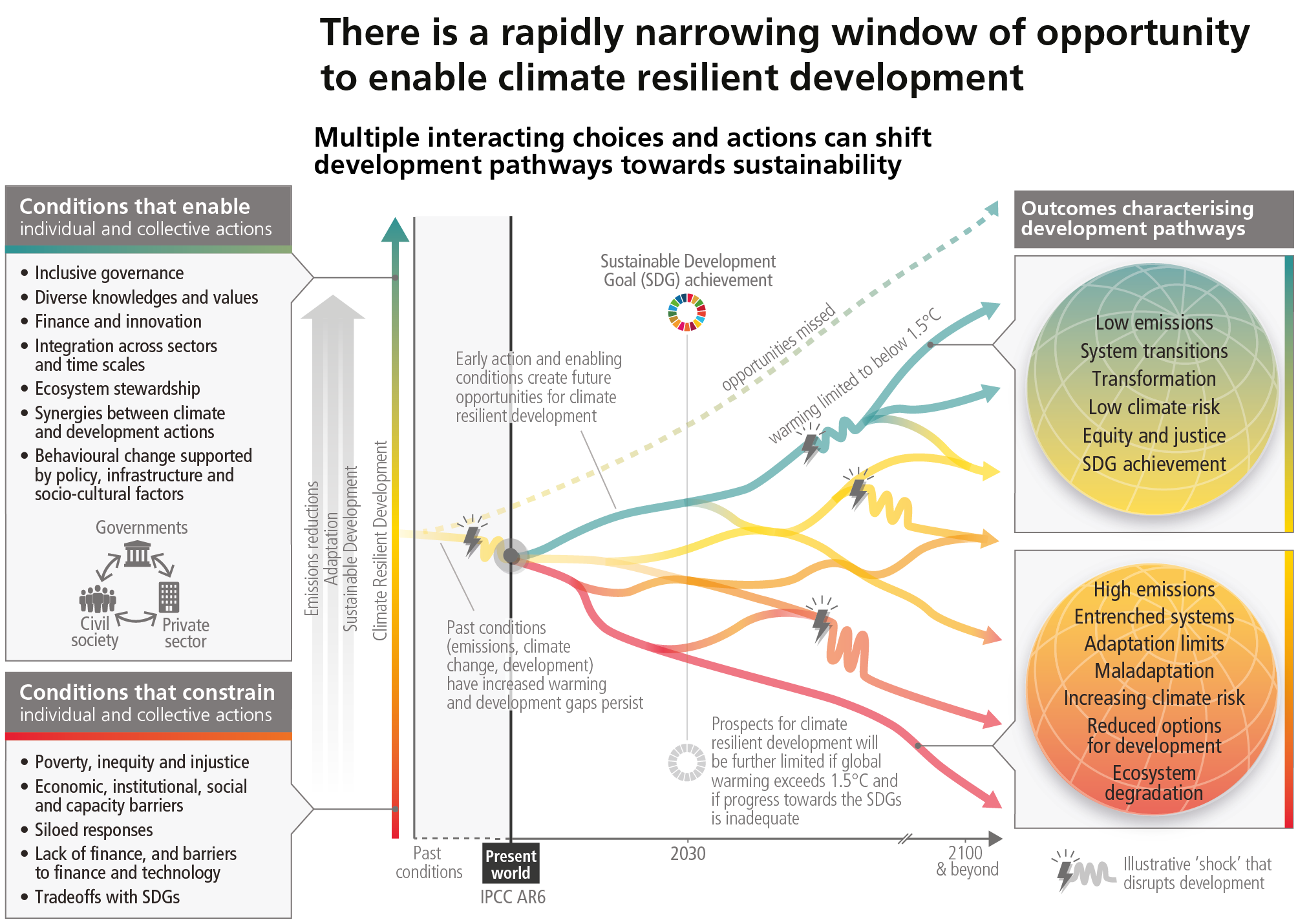
Figure SPM.6 note: The illustrative development pathways (red to green↑) and associated outcomes ( panel on the right) show that there is a rapidly narrowing window of opportunity to secure a liveable and sustainable future for all. (see the IPCC note on figure SPM.6 for more details)
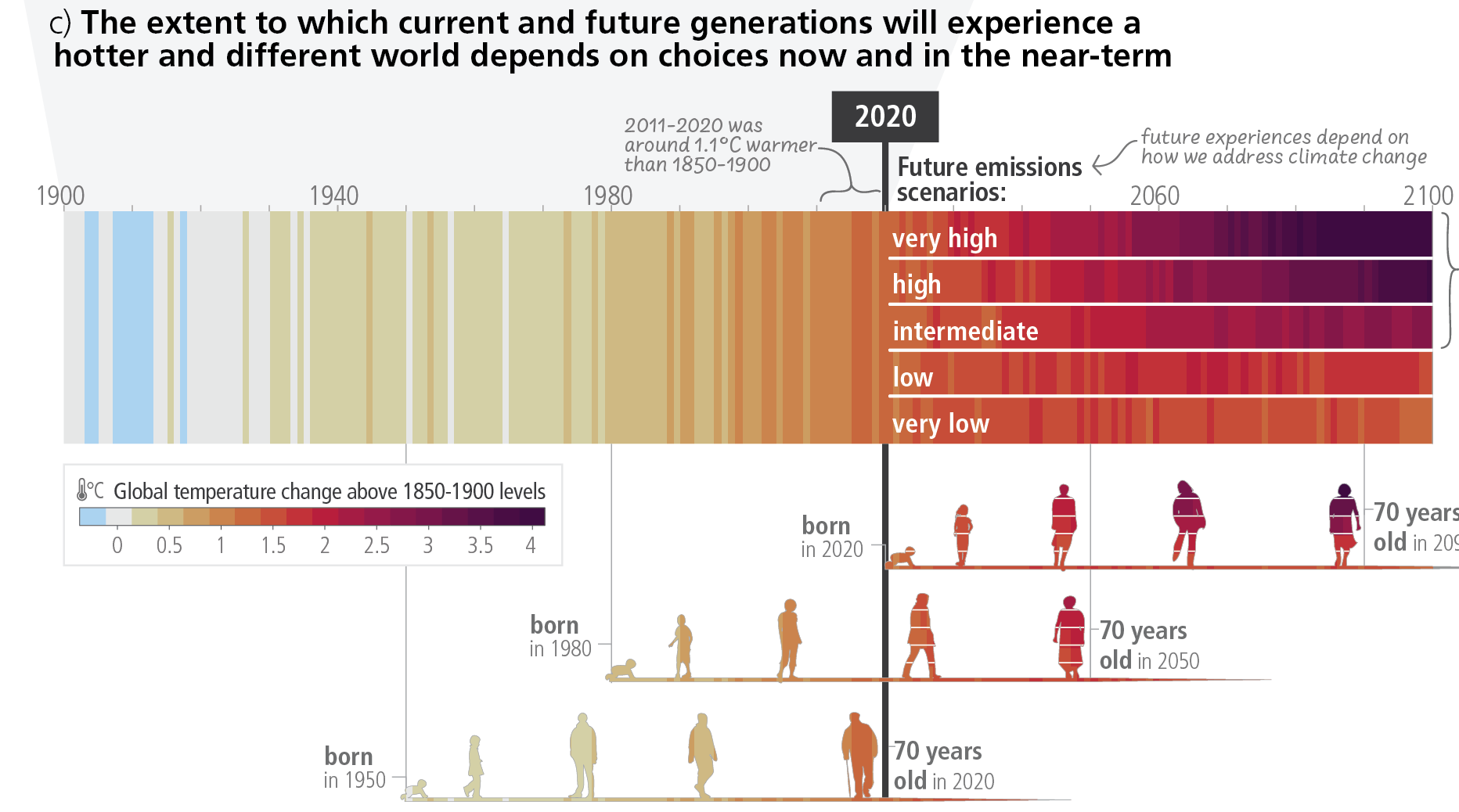
1
Step 1: In pairs, explore the following questions:
2
Step 2: Explore the answers to the above questions as a class.
3
Step 3: Write answers to the above questions in your copy books.
Study the Figure 2: The extent to which current and future generations will experience a hotter and different world depends on choices now and in the near future and identify the different interactive choices and actions that can shift development pathways towards sustainability.
Q1. Identify three enabling conditions and constraining factors associated with sustainable development.
| Enabling Conditions | Constraining Factors |
|---|---|
| 1. | 1. |
| 2. | 2. |
| 3. | 3. |
Q2. Can you give an example of a situation where lack of X (any enabling condition, such as inclusive governance) could constrain collective action? Justify your answer with evidence.
Q3(a). Research a definition for the term ‘trade-offs’.
Key Term | Key Term |
● Trade-offs | ● Synergies: The interaction or cooperation of two or more organisations, substances, or other agents to produce a combined effect greater than the sum of their separate effects. |
Q. 3(b). In your opinion, what do the ‘trade-offs’ with the sustainable development goals mentioned in the image mean?
To understand how the achievement of one Sustainable Development Goal (SDG) can impact progress on another SDG, read the text below carefully. Note: The text is taken from the United Nations Development Programme (UNDP) SDG Investor Platform:
‘There are times when progress on one SDG could reduce or backtrack advances on another.Trade-offs occur because the SDGs with high trade-off percentages are focused on economic growth.For example, Reducing Poverty (SDG1) runs through several SDGs. It is statistically linked to favouring the progress of Good Health and Well-Being (SDG3), Quality Education (SDG4), Gender Equality (SDG5), Clean Water and Sanitation (SDG6), and Reduced Inequalities (SDG10), according to the UN SDG Report 2021.
Being aware of the negative synergies is important. For example, Zero Hunger (SDG2) might be achieved faster at the expense of Life Below Water (SDG14), through overfishing. Another example is Decent Work and Economic Growth (SDG8) could be achieved either hand-in-hand with positive climate action (SDG13) or at its expense depending on the path taken, for instance if decent work and economic growth is achieved through employment in fossil fuel extraction.
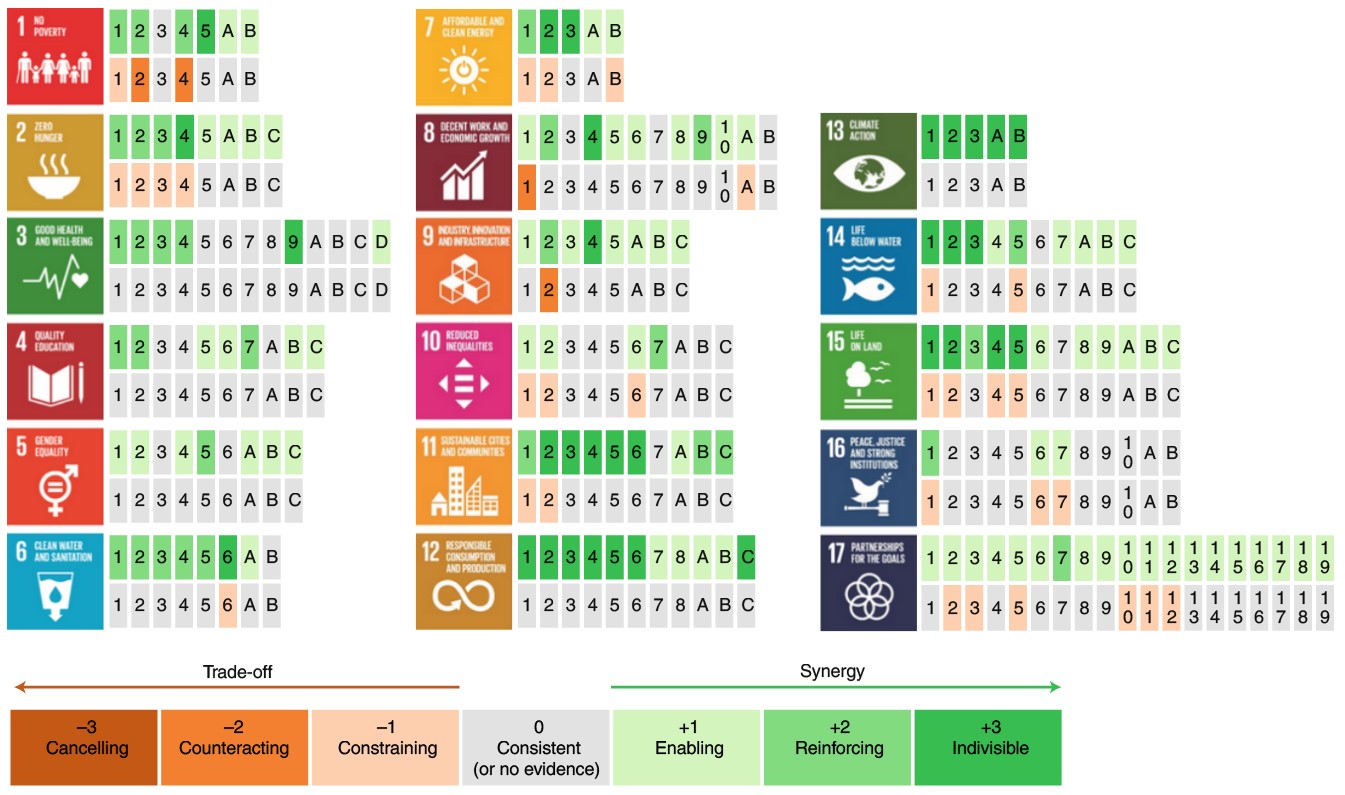
Note:
To explore this figure in more detail, including supplementary notes, visit the Nature Sustainability journal article Connecting climate action with other Sustainable Development Goals online.
Update: this post was updated to integrate recent developments in Shein’s sustainability efforts in mid-2023 (First published on 11/05/2023).
About the author
The following individuals were particularly important in compiling this handbook:

This resource is for post primary school teachers who wish to facilitate understanding of the interconnection between war and hunger. The Resource itself is divided

This Greenwashing myths pocket-size booklet includes: Why thinking about Greenwashing matters 10 short myths exploring buzzwords, marketing tactics and green credentials of businesses and governments
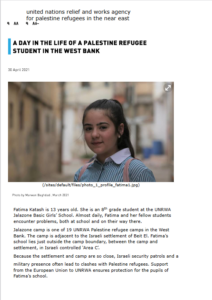
“Fatima Katash is 13 years old. She is an 8th grade student at the UNRWA Jalazone Basic Girls’ School. Almost daily, Fatima and her fellow
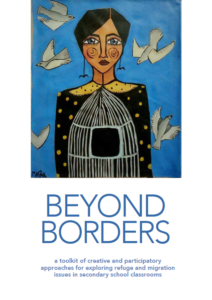
This pack provides a range of creative and active-learning methodologies and links for educators wishing to explore some of the sensitive and complex issues around
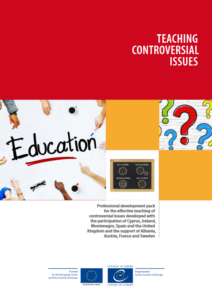
Living with Controversy; Teaching Controversial Issues Through Education for Democratic Citizenship and Human Rights training pack for teachers is designed primarily for the benefit of
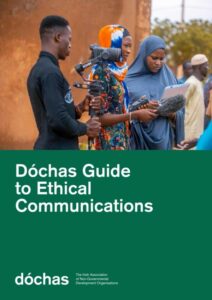
The Dóchas Guide to Ethical Communications is a resource for international humanitarian and development non-governmental organisations (NGOs) when designing and implementing their communications. The Guide
DevelopmentEducation.ie is an online resource for teachers, educators, change makers and learners focused on the unequal and unjust shape of the world today. Find out more
Except where otherwise noted, text-based content on this website may be used in accordance with the Creative Commons Attribution-ShareAlike 4.0 International (CC BY-SA 4.0) license. Except where otherwise noted, images on this site are © the attributed photographer/artist/illustrator or representative agency. For information please refer to our Content Policy
Copyright © 1999-2026 DevelopmentEducation.ie